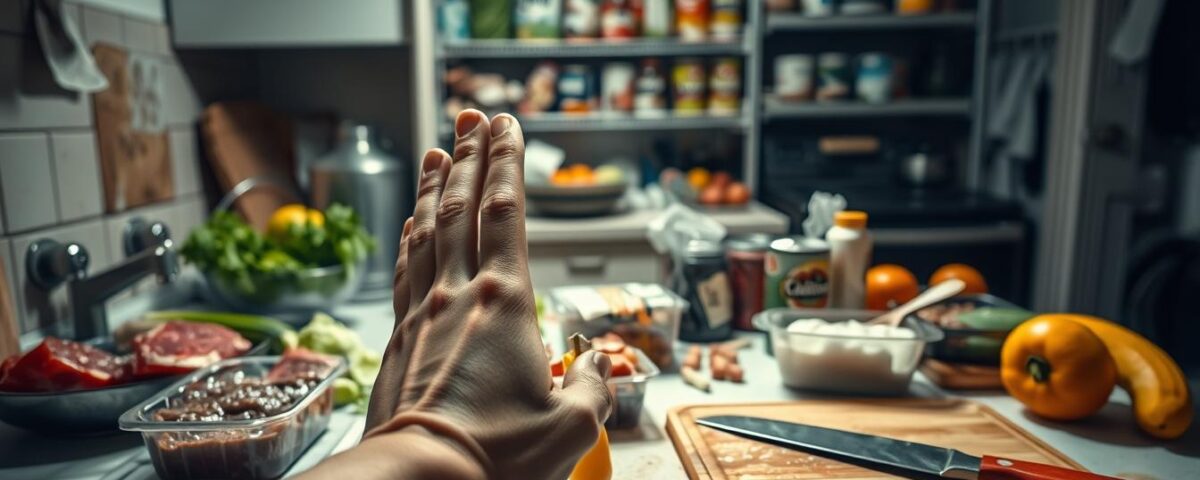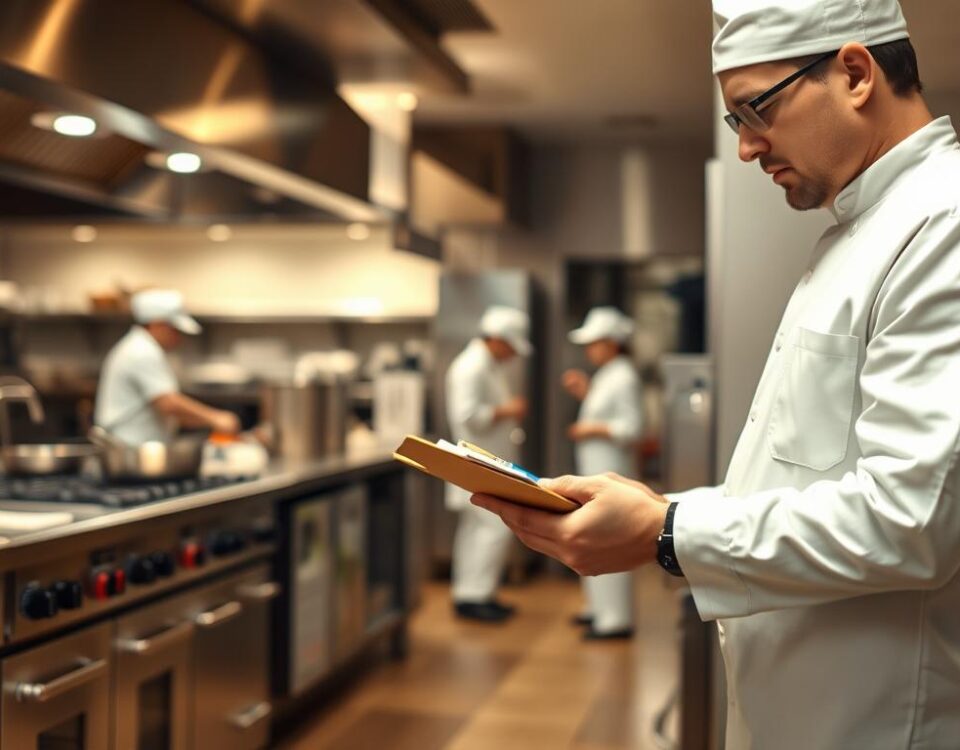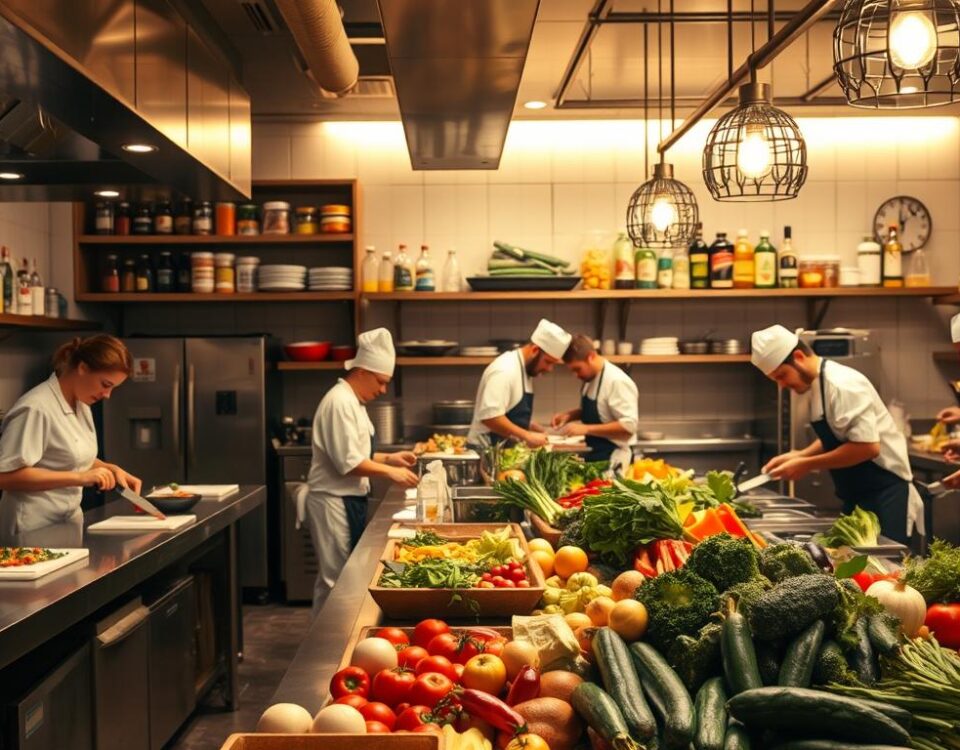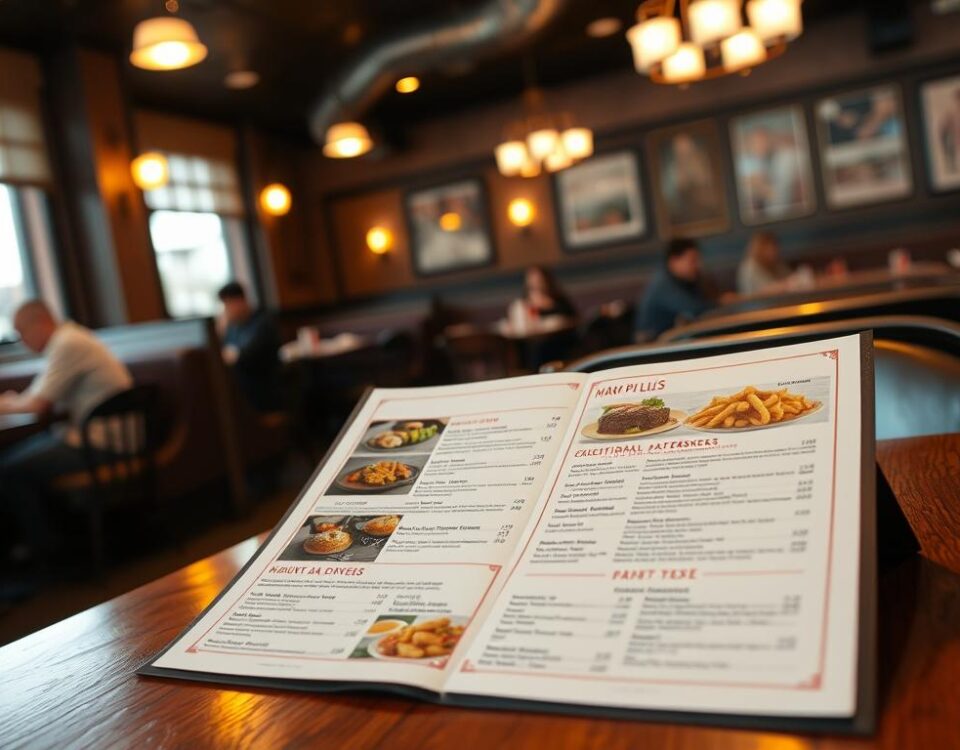
6 Hidden Food Safety Risks That Could Jeopardize Your Restaurant
July 15, 2025
The Legal Checklist Every New Restaurant Must Complete Before Day One
July 16, 2025As someone who’s spent years working in commercial kitchens, I’ve seen firsthand how simple food handling errors can lead to serious health code violations, putting customers and businesses at risk.
The Centers for Disease Control and Prevention (CDC) estimates that approximately 48 million Americans get sick from foodborne illnesses each year, resulting in 128,000 hospitalizations and 3,000 deaths. Most of these cases could be prevented with proper handling and safety protocols in place.
Understanding the most common errors that lead to health code violations is crucial for protecting your customers, your reputation, and your business. In this article, I’ll walk you through four critical food safety mistakes and provide actionable solutions to improve your kitchen’s safety practices.
Key Takeaways
- Identify the most common food handling errors that lead to health code violations.
- Understand the importance of proper food safety protocols in commercial kitchens.
- Learn actionable solutions to improve your kitchen’s safety practices.
- Reduce the risk of health code violations and protect your customers and business.
- Implement effective food safety measures to prevent foodborne illnesses.
The Hidden Dangers in Your Kitchen
Your kitchen is where meals are made, but it can also be a breeding ground for bacteria that cause foodborne illnesses. The Center for Disease Control and Prevention estimates that foodborne illness affects roughly 48 million people in the United States, or 1 in 6 Americans, with 128,000 hospitalizations and 3,000 deaths annually.
Why Food Safety Matters
Food safety is crucial because it directly impacts public health. Ensuring that the food we consume is safe is vital to preventing foodborne illnesses. Salmonella, for instance, is a common cause of hospitalization due to foodborne illness outbreaks, with over 19,000 cases per year.
The Cost of Health Code Violations
Health code violations can have severe consequences on a food business. I’ve witnessed firsthand how these violations can lead to hefty fines, mandatory closures, and lasting damage to a business’s reputation. The long-term costs, including lost customer trust, can be incalculable. In today’s digital age, health inspection reports are publicly accessible, making it crucial to maintain high food safety standards.
Understanding Food Safety Mistakes and Their Consequences
Food safety mistakes can have severe consequences, affecting not only the health of consumers but also the reputation and financial stability of businesses. Salmonella and other pathogens can contaminate food through various means, including improper handling, contamination during manufacturing or distribution, and unsafe practices on farms.
The Alarming Statistics
The statistics surrounding food safety are alarming. I’ve seen health code violations impact businesses in multiple ways, from immediate operational disruptions to long-term financial consequences. The data highlights the importance of adhering to food safety guidelines to prevent such outcomes.
How Violations Impact Your Business
When health inspectors identify critical violations, they may require immediate correction, which can mean disposing of food, closing sections of your kitchen, or even shutting down operations entirely. The financial impact extends beyond fines, with lost inventory, wasted food, emergency staff training, and lost business during closures all adding up quickly.
| Consequence | Immediate Impact | Long-term Effect |
|---|---|---|
| Operational Disruption | Closure of kitchen sections or entire operations | Loss of customer trust and loyalty |
| Financial Loss | Fines, lost inventory, wasted food | Increased insurance premiums, potential rebranding costs |
| Reputational Damage | Negative reviews and publicity | Long-term loss of business and revenue |

Mistake #1: Cross-Contamination – The Silent Spreader
One of the most significant threats to food safety in any kitchen is cross-contamination, a silent spreader of harmful bacteria. As someone who has witnessed many kitchens struggle with this issue, I can attest to its prevalence and potential danger.
Cross-contamination can occur in several ways, including food-to-food, people-to-food, and equipment-to-food contamination. Let’s delve into each of these categories to understand how they happen and how to prevent them.
Food-to-Food Contamination
Food-to-food contamination happens when bacteria from one food item are transferred to another. For instance, using the same cutting boards and knives for raw meats and ready-to-eat foods without proper cleaning in between can lead to cross-contamination. I recommend color-coding your cutting boards and knives to prevent this.
People-to-Food Contamination
People-to-food contamination occurs when food handlers inadvertently transfer bacteria to food. This can happen through improper handwashing or touching contaminated surfaces before handling food.
Equipment-to-Food Contamination
Equipment-to-food contamination is another common issue. Reusing unclean equipment like slicers, knives, cutting boards, can openers, and other utensils to prepare food can spread bacteria. Storing cooked foods in unsanitized containers is also a risk. To mitigate this, ensure that all equipment is thoroughly cleaned and sanitized between uses.
By understanding these risks and taking steps to mitigate them, kitchens can significantly reduce the risk of cross-contamination and ensure a safer environment for food preparation.
How to Prevent Cross-Contamination in Your Kitchen
Preventing cross-contamination in your kitchen is crucial for maintaining food safety. Cross-contamination occurs when bacteria or other pathogens are transferred from one food to another, often through improper handling or equipment. To prevent this, it’s essential to implement proper food storage and handling techniques.
Proper Food Storage Techniques
Proper food storage is a critical step in preventing cross-contamination. Store raw meat, poultry, and seafood in sealed containers at the bottom of the refrigerator to prevent juices from dripping onto other foods. Use cutting boards wisely by choosing the right type for the food you’re preparing.
The Right Way to Use Cutting Boards
When it comes to cutting and preparing food, the type of cutting board you use matters. Here are some tips to follow:
- Maintain separate boards for different food types, ideally color-coded for easy identification.
- Use plastic cutting boards for raw meat, poultry, and seafood because they can be sanitized in a dishwasher at high temperatures.
- Reserve wooden boards for produce, bread, and other ready-to-eat foods—never use them for raw meat.
- Replace cutting boards once they develop deep grooves or cuts that can harbor bacteria even after cleaning.
By following these guidelines, you can significantly reduce the risk of cross-contamination in your kitchen and ensure a safer food preparation environment.
Mistake #2: Temperature Danger Zone Violations
Temperature control is crucial in the kitchen, and violating temperature guidelines can lead to serious health code infractions. Leaving food on a countertop to marinate or thaw may be tempting, but it can be highly dangerous. Marinating and thawing should be done in temperature-controlled environments that meet FDA Food Code temperature guidelines.

Understanding the Danger Zone
The danger zone refers to the temperature range between 40°F and 140°F, where bacteria such as Staphylococcus aureus, Salmonella enteritidis, E. coli, and Campylobacter can rapidly grow. It’s essential to keep food out of this range to prevent bacterial growth.
Bacteria Growth Timeline
Bacteria can double in number every 20 minutes when food is left in the danger zone. This rapid growth can lead to dangerous levels of bacteria, making consumers sick.
Common Temperature Monitoring Errors
Several common mistakes can lead to temperature danger zone violations. These include relying on visual cues instead of using a thermometer, not inserting the thermometer into the thickest part of the food, failing to calibrate thermometers regularly, and using the same thermometer for different foods without sanitizing between uses.
| Error | Description | Consequence |
|---|---|---|
| Relying on visual cues | Not using a thermometer to check food temperature | Inaccurate temperature assessment |
| Incorrect thermometer use | Not inserting thermometer into the thickest part of the food | Inaccurate core temperature reading |
| Failing to calibrate thermometers | Not regularly checking thermometer accuracy | Inaccurate temperature readings |
Essential Temperature Guidelines for Food Safety
One of the most critical aspects of food safety is adhering to essential temperature guidelines to prevent foodborne illnesses. Temperature control is vital during cooking, cooling, and reheating to ensure that food is prepared and stored safely.
Safe Cooking Temperatures for Different Foods
Cooking food to the correct internal temperature is crucial for destroying harmful bacteria. Different types of food have specific minimum cooking temperatures. For instance, ground beef, pork, veal, and lamb should be cooked to at least 160 ℉, while poultry should reach 165 ℉. Using a food thermometer is the only reliable way to ensure that food has reached a safe internal temperature.
| Food Type | Minimum Cooking Temperature |
|---|---|
| Ground beef, pork, veal, lamb | 160 ℉ |
| Poultry | 165 ℉ |
| Fresh beef, veal, lamb | 145 ℉ (with 3 minutes rest) |
| Fish | 145 ℉ |
Proper Cooling and Reheating Procedures
Improper cooling is a common cause of foodborne illness. The FDA requires cooling hot foods from 135°F to 70°F within two hours and then to 41°F within an additional four hours. To cool foods effectively, divide large batches into smaller containers and use ice baths. When reheating, food must reach 165°F within two hours. Using a food thermometer to verify the temperature is essential.
- Divide large batches into smaller, shallow containers for cooling.
- Use ice baths for rapid cooling.
- Reheat food to 165°F within two hours.

Mistake #3: Improper Handwashing and Personal Hygiene
One of the most significant oversights in food safety is the failure to adhere to proper handwashing protocols. Hand hygiene is a critical aspect of preventing foodborne illnesses, and its importance cannot be overstated.
The Link Between Hands and Foodborne Illness
Hands can be a significant source of contamination in the kitchen. According to the FDA, food service workers should wash their hands after any event that “contaminates the hands.” This includes before starting food preparation, after handling raw foods, and after using the toilet, among other critical times.
When Handwashing Is Critical
Handwashing is not just a routine task; it’s a critical step in food safety. Workers should wash their hands before putting on clean gloves, when switching between handling raw and ready-to-eat foods, and after touching any surface that may be contaminated.
Common Handwashing Shortcuts That Cause Problems
I’ve observed several harmful shortcuts in handwashing routines that compromise food safety. For instance, the “splash and dash” method, where hands are quickly run under water without soap or proper scrubbing, is ineffective. Other mistakes include using hand sanitizer as a substitute for handwashing, drying hands on contaminated aprons or uniforms, and not washing hands for the full recommended 20 seconds.
As emphasized by food safety guidelines, “proper handwashing requires a full 20 seconds of scrubbing with soap to be effective.” By avoiding these common shortcuts and adhering to proper handwashing techniques, kitchens can significantly reduce the risk of foodborne illnesses.
The Correct Handwashing Technique for Food Handlers
As a food handler, washing your hands correctly is crucial to preventing the spread of illnesses. Effective hand hygiene is a simple yet powerful tool in maintaining food safety.
Step-by-Step Handwashing Protocol
The FDA Food Code emphasizes that friction and warm water play a critical role in handwashing. To wash your hands properly, use soap and scrub all surfaces for at least 10-15 seconds. Ensure that you scrub, rinse, and dry your hands thoroughly.
Beyond Handwashing: Other Personal Hygiene Requirements
Proper food handler hygiene extends beyond just clean hands. Here are some key considerations:
- Wear clean, appropriate work attire, changing uniforms daily.
- Use hair restraints to prevent hair from falling into food.
- Keep fingernails short, clean, and unpolished.
- Minimize jewelry to prevent bacteria harboring and contamination.
- Cover cuts and wounds with waterproof bandages and gloves.
Mistake #4: Improper Cleaning and Sanitizing Practices
I’ve seen firsthand how improper cleaning and sanitizing practices can lead to serious health code violations. Maintaining a clean and sanitized environment is crucial for food safety, and it’s an area where many kitchens fall short. The consequences of such oversights can be severe, ranging from foodborne illnesses to significant financial losses due to failed health inspections.
The Difference Between Cleaning and Sanitizing
Many kitchen staff confuse cleaning with sanitizing, but these are distinct processes. Cleaning removes visible dirt and debris, while sanitizing reduces the number of pathogens on a surface to a safe level. Understanding this difference is key to implementing effective food safety protocols.
Forgotten Cleaning Hotspots
Kitchens often overlook certain areas when it comes to cleaning and sanitizing. Commonly neglected spots include the handles of refrigerators, storage areas, and equipment like slicers and mixers. Regularly checking and sanitizing these hotspots can significantly reduce the risk of contamination.
Sanitizer Concentration Errors
Using sanitizer solutions at the wrong concentration is a frequent mistake. Solutions that are too weak fail to kill harmful bacteria, while those that are too strong can leave toxic residues. I’ve tested numerous sanitizer solutions and found that concentration errors are alarmingly common. To avoid this, it’s essential to use test strips to verify the concentration of sanitizer solutions and to follow the manufacturer’s instructions for the correct dilution ratio.
| Sanitizing Product | Recommended Concentration | Contact Time |
|---|---|---|
| Chlorine-based sanitizer | 50-100 ppm | 1-2 minutes |
| Quaternary ammonium sanitizer | 150-400 ppm | 1-2 minutes |
Implementing an Effective Cleaning and Sanitizing Program
An effective cleaning and sanitizing program is the backbone of food safety in any kitchen. This program ensures that all surfaces and equipment are properly cleaned and sanitized to prevent the spread of bacteria and other pathogens.
Creating a Cleaning Schedule
To maintain consistency, it’s essential to create a cleaning schedule that outlines the tasks to be performed daily, weekly, and monthly. This schedule helps ensure that no area or equipment is overlooked.
Choosing the Right Cleaning Products
When selecting cleaning products, it’s crucial to choose those specifically formulated for food service environments. Different surfaces and equipment require different products, and all cleaning chemicals used must be food-safe and approved for commercial kitchens.
- Select products that are suitable for the specific surface or equipment.
- Ensure proper dilution of concentrated products to avoid toxicity or ineffectiveness.
- Store cleaning products separately from food items to prevent contamination.
- Provide staff training on the proper use of cleaning products, including contact times and safety precautions.
- Maintain organized safety data sheets (SDS) for all cleaning products used.
Conclusion: Building a Culture of Food Safety
Building a culture of food safety is not just about following rules; it’s about creating an environment where safety is paramount. In my experience, the most successful kitchens don’t just comply with regulations—they instill a sense of responsibility among their staff.
Preventing common food safety mistakes requires consistent effort and attention to detail from everyone on the team. Regular training and refresher courses are crucial in keeping food safety knowledge current and demonstrating a commitment to protecting customers.
By empowering staff to speak up when they see potential violations, kitchens can create an environment where safety is valued at every level. Leading by example is also crucial, as managers who follow proper food safety protocols inspire their teams to do the same.
Remember, food safety isn’t just about passing inspections—it’s about protecting your customers, your reputation, and your business. By addressing these common mistakes, you’ll significantly reduce your risk of health code violations while providing safer food for your customers.
FAQ
What is the most common cause of cross-contamination in the kitchen?
The most common cause of cross-contamination is using the same cutting boards and utensils for different types of meat and poultry without proper cleaning and sanitizing.
How often should I wash my hands when handling raw meat?
You should wash your hands with soap and water before and after handling raw meat, poultry, or eggs to prevent the spread of harmful bacteria.
What is the danger zone for bacterial growth, and how can I avoid it?
The danger zone is between 40°F and 140°F, where bacteria can multiply rapidly. To avoid it, keep hot foods hot and cold foods cold, and never leave perishable foods at room temperature for more than two hours.
How can I ensure that my cutting boards are properly sanitized?
To sanitize your cutting boards, wash them with soap and water, then sanitize with a solution of one tablespoon of unscented bleach in one gallon of water.
What is the correct internal temperature for cooking chicken and turkey?
The correct internal temperature for cooking chicken and turkey is 165°F. Use a thermometer to ensure that the meat is cooked to a safe temperature.
How often should I clean and sanitize my kitchen utensils and equipment?
You should clean and sanitize your kitchen utensils and equipment after each use, and at least every four hours during continuous use.
Can I leave cooked leftovers at room temperature if I plan to refrigerate them later?
No, you should not leave cooked leftovers at room temperature for more than two hours. Refrigerate or freeze them promptly to prevent bacterial growth.



